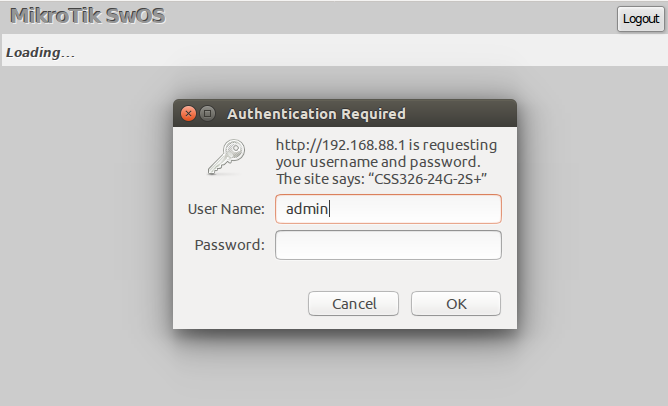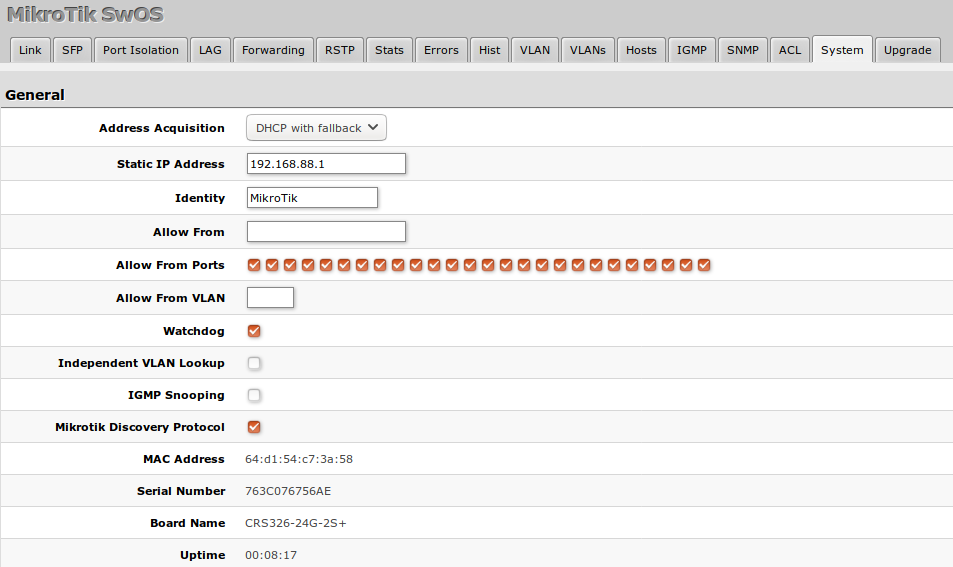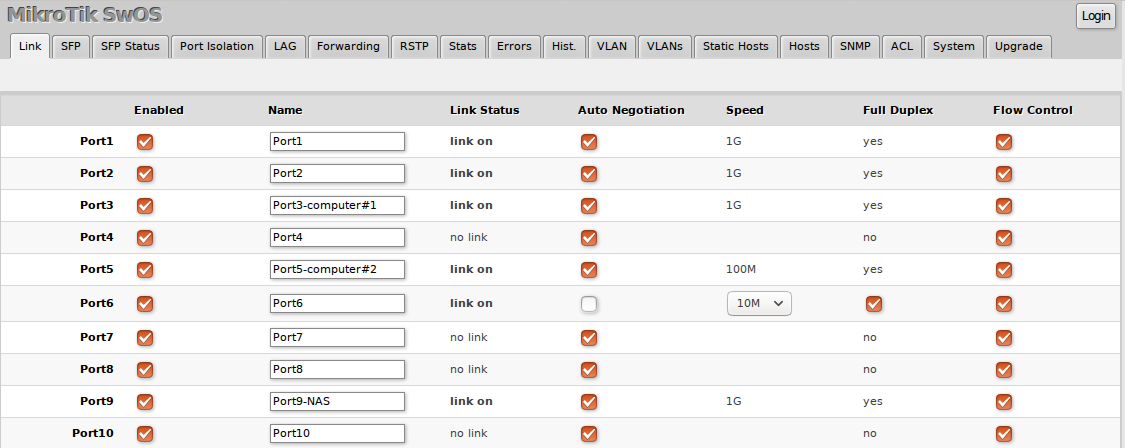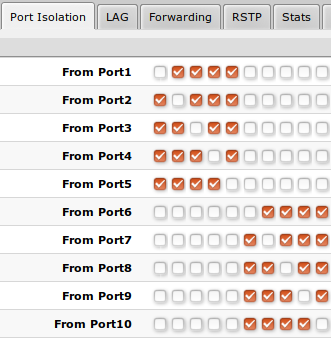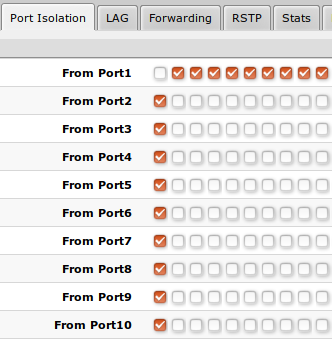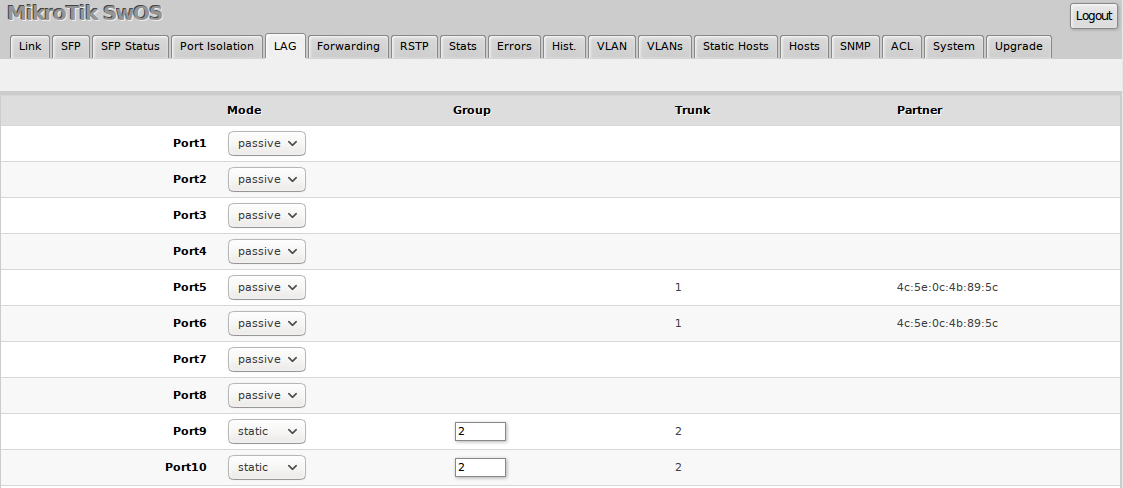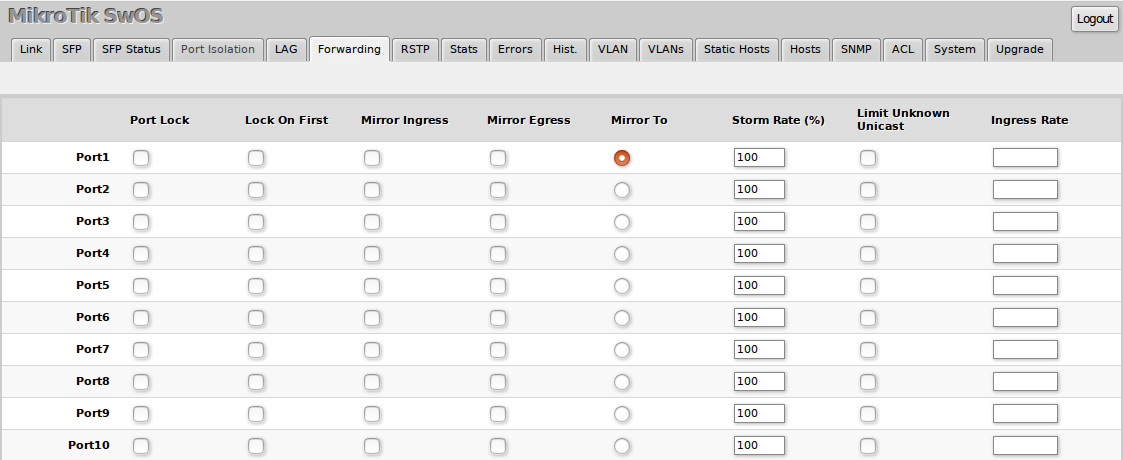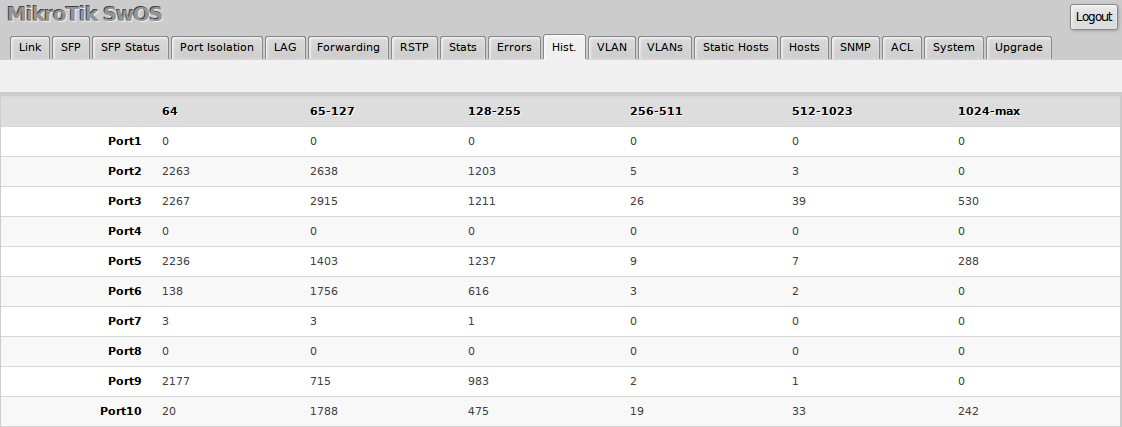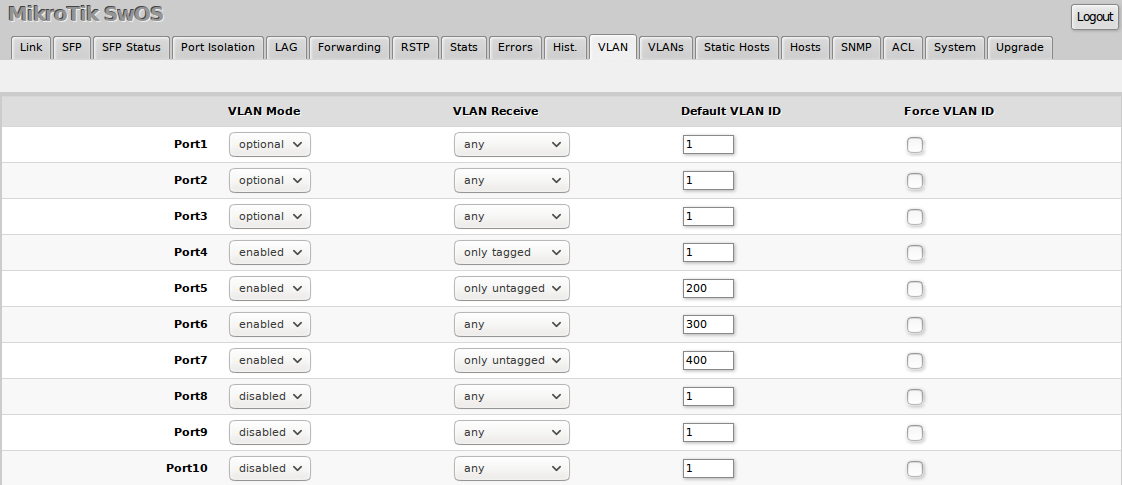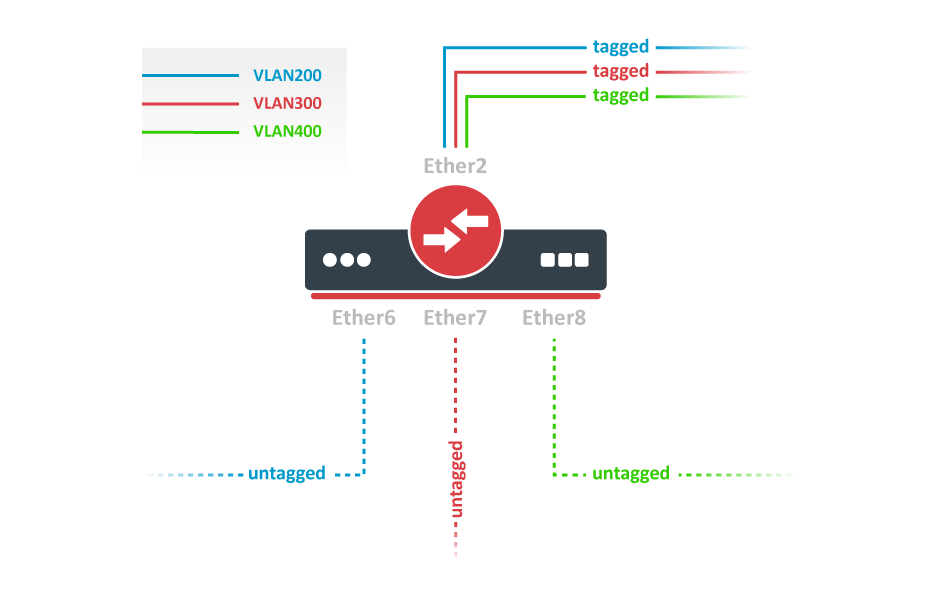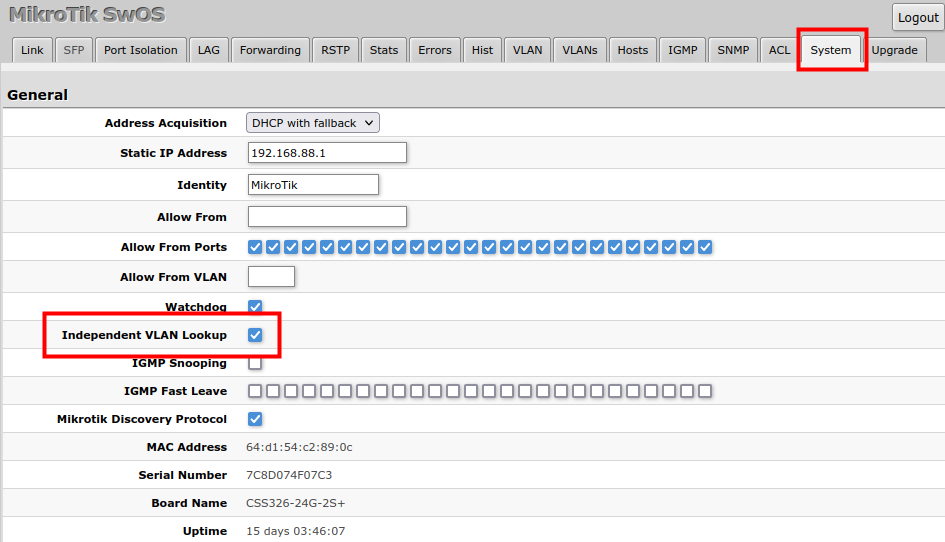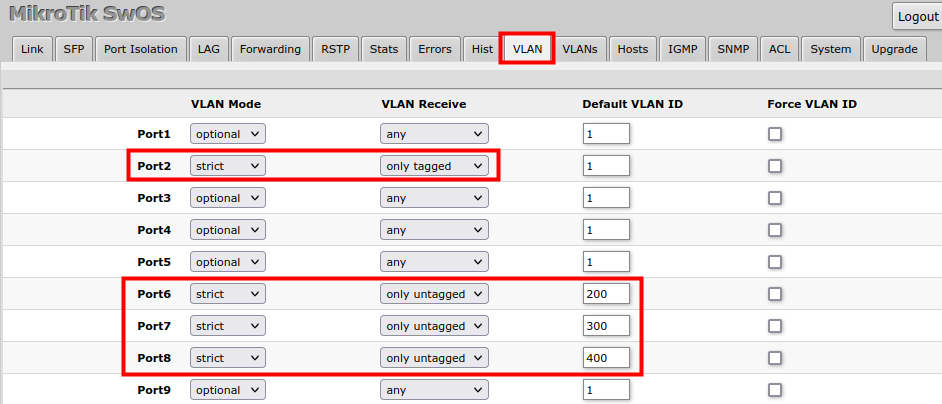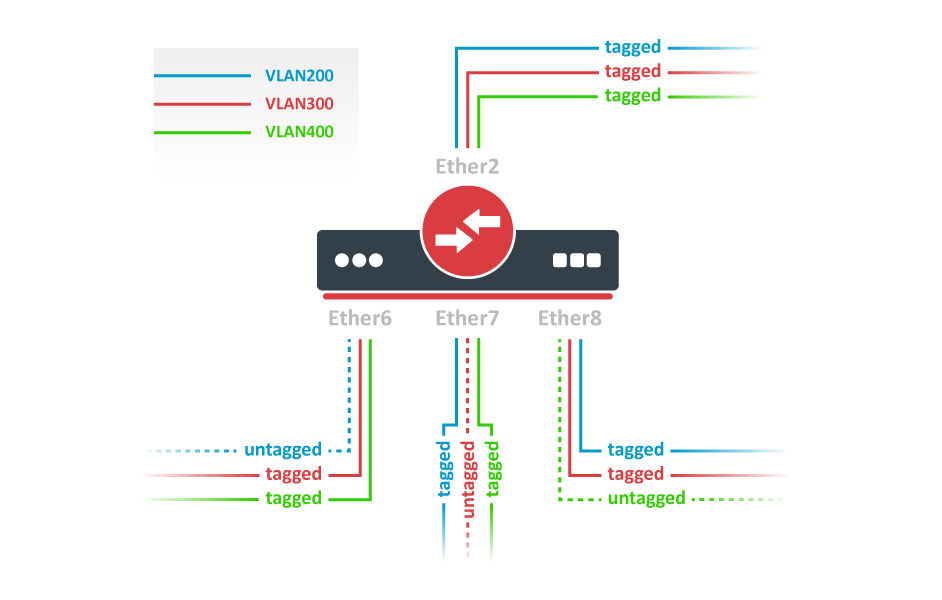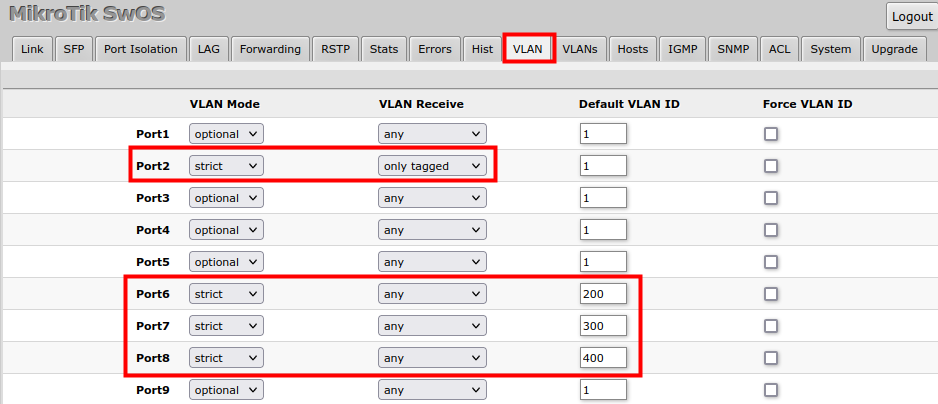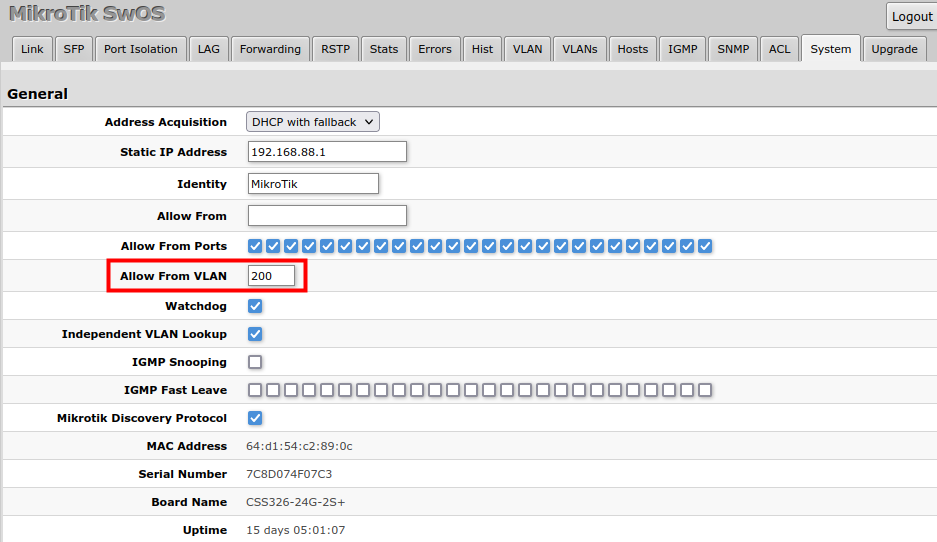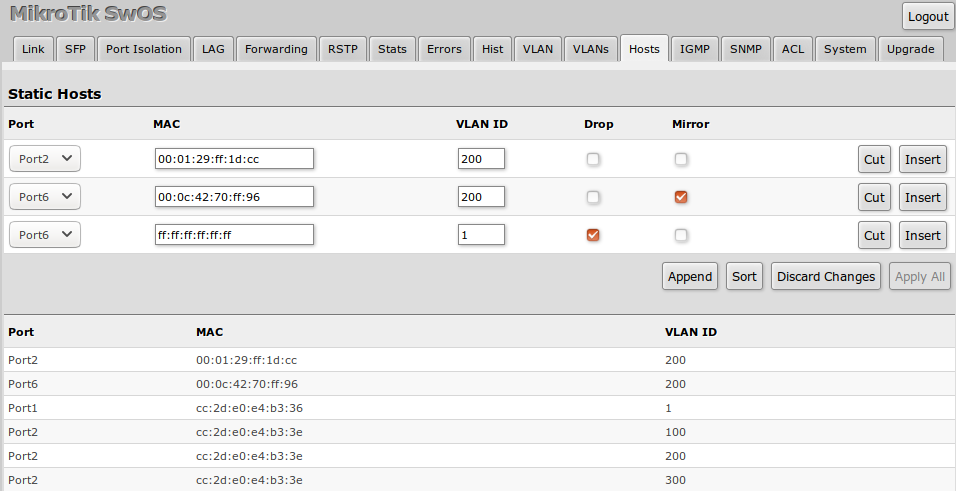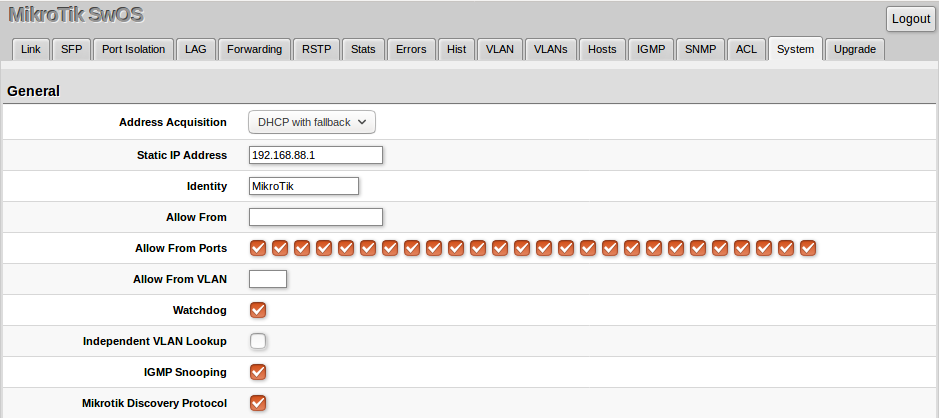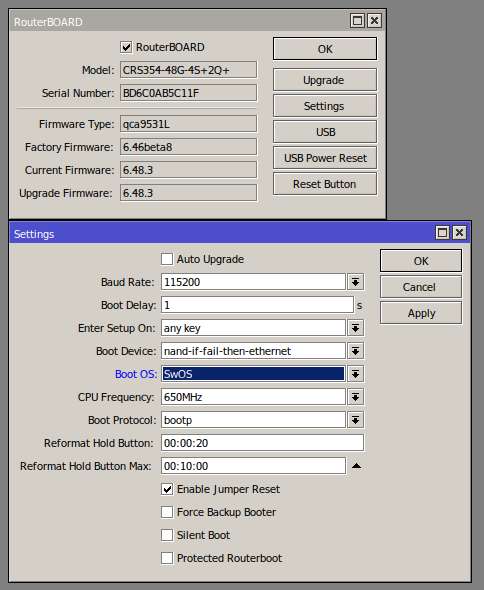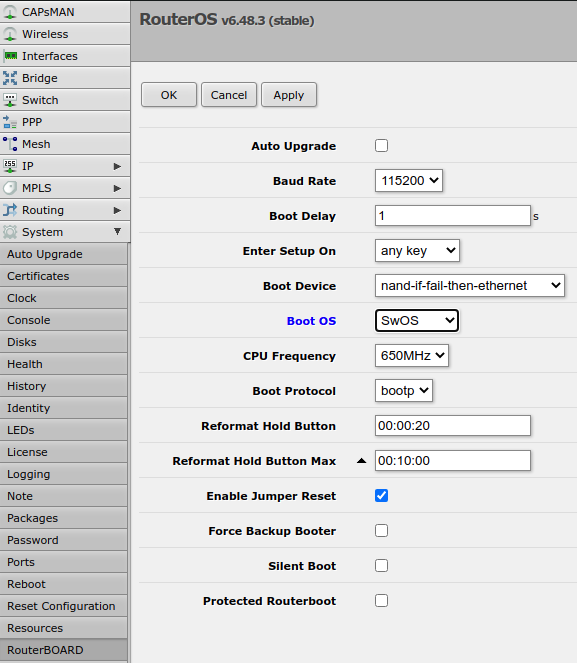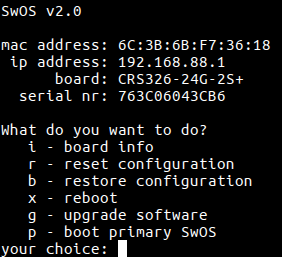Connecting to the Switch
Open your web browser and enter the IP address of your switch (192.168.88.1 by default) and a login screen will appear. The switch can also run a DHCP client, see if a different IP address has been assigned by the DHCP server.
SwOS default IP address: 192.168.88.1, user name: admin and there is no password.
MikroTik Neighbor Discovery can be used to discover the IP address of the Mikrotik switch. LLDP is not supported.
System
System Tab performs the following functions:
General information about switch
Switch management
Configuration reset
Backup and restore configuration
SwOS uses a simple algorithm to ensure TCP/IP communication - it just replies to the same IP and MAC address packet came from. This way there is no need for Default Gateway on the device itself.
DHCP & PPPoE Snooping
Password and Backup
Link
Link Tab allows you to configure each interface settings and monitor the link status.
PoE
Devices with PoE-out support have some configuration options and certain monitoring features, like PoE-out current, voltage, etc. For more details about PoE, see the PoE-Out manual.
If the Voltage Level is set to "auto" and PoE Out is set to "on", the low voltage will be used by default. If the PD supports only high voltage, make sure you also set Voltage Level to "high" when forcing the PoE output.
SFP
SFP tab allows you to monitor the status of SFP/SFP+ modules.
Port Isolation
The Port Isolation table allows or restricts traffic forwarding between specific ports. By default, all available switch chip ports can communicate with any other port, there is no isolation used. When the checkbox is enabled/ticked you allow to forward traffic from this port towards the ticked port. Below are some port isolation examples.
In some scenarios, you might need to isolate a group of devices from other groups. In this example devices on Port1-Port5 are not able to communicate with Port6-Port10 devices, and vice versa.
In some scenarios, you might need to forward all traffic to an uplink port while all other ports are isolated from each other. This kind of setup is called a Private VLAN configuration. The switch will forward all Ethernet frames only to the uplink Port1, while uplink can reach all other ports
Individual isolated Port1 (e.g. for management purpose), it cannot send or receive traffic from any other port
It is possible to check/uncheck multiple checkboxes by checking one of them and then dragging horizontally (Click & Drag).
(R)STP will only work properly in Private VLAN setups. In setups with multiple isolated switch groups (R)STP might not properly receive BPDUs and therefore fail to detect network loops.
LAG
IEEE 802.3ad (LACP) compatible link aggregation is supported, as well as static link aggregation to ensure failover and load balancing based on Layer2, Layer3 and Layer4 hashing. Up to 16 link aggregation groups with up to 8 ports per group are supported. Each individual port can be configured as Passive LACP, Active LACP, or a Static LAG port.
Forwarding
Forwarding Tab provides advanced forwarding options among switch ports, port locking, port mirroring, bandwidth limit, and broadcast storm control features.
It is possible to limit ingress traffic per-port basis with traffic policer. The ingress policer controls the received traffic with packet drops. Everything that exceeds the defined limit will get dropped. This can affect the TCP congestion control mechanism on end hosts and achieved bandwidth can be actually less than defined.
RSTP
Per-port and global RSTP configuration and monitoring are available in the RSTP menu.
Stats, Errors and Histogram
These menus provide detailed information about received and transmitted packets.
Statistics for SFP+ interface are cleared whenever an active SFP+ link is established.
VLAN and VLANs
VLAN configuration for switch ports.
VLAN membership configuration for switch ports.
VLAN Configuration Example
Trunk and Access Ports
In the System menu enable independent VLAN learning (IVL).
In the VLANs menu add VLAN entries and specify port membership.
In the VLAN menu configure Default VLAN ID on planned access ports (untagged), select the correct VLAN Receive setting (Port2 only tagged, Port6-8 only untagged) and enable strict VLAN filtering to ensure only allowed VLANs can pass through the ports.
Trunk and Hybrid Ports
In the System menu enable independent VLAN learning (IVL).
In the VLANs menu add VLAN entries and specify port membership.
In the VLAN menu configure Default VLAN ID on planned hybrid ports (for untagged VLAN), select the correct VLAN Receive setting (Port2 only tagged, Port6-8 any) and enable strict VLAN filtering to ensure only allowed VLANs can pass through the ports.
Management access
In this example, switch management access on VLAN 200 will be created. The configuration scheme is the same as "Trunk and Access Ports" and 1., 2., 3. configuration steps are identical. The additional 4th step requires to specify the management VLAN ID in the System menu. After applying the configuration, switch will only respond to tagged VLAN 200 packets on Port2 and untagged packets on Port6. The DHCP client will also work in the specified VLAN ID.
Changing management VLAN can completely disable access to the switch management if VLAN settings are not correctly configured. Save a configuration backup before changing this setting and use Reset in case management access is lost.
Hosts
This table represents dynamically learned MAC address to port mapping entries. It can contain two kinds of entries: dynamic and static. Dynamic entries get added automatically, this is also called a learning process: when a switch receives a packet from a certain port, it adds the packet's source MAC address and port it received the packet from to the host table, so when a packet comes in with a certain destination MAC address it knows to which port it should forward the packet. If the destination MAC address is not present in the host table then it forwards the packet to all ports in the group. Dynamic entries take about 5 minutes to time out.
Static entries will take over dynamic if dynamic entry with same mac-address already exists. Also by adding a static entry you get access to more functionality.
IGMP Snooping
IGMP Snooping which controls multicast streams and prevents multicast flooding is implemented in SwOS starting from version 2.5. The feature allows a switch to listen in the IGMP conversation between hosts and routers.
Enable this option under the System tab. Since SwOS 2.13 version, IGMP Fast Leave option can also be configured.
Available IGMP snooping data can be found under the IGMP tab.
It is possible to enable IGMP Snooping for a specific VLAN ID under the VLANs menu.
IGMP Snooping for VLANs requires enabled "Independent VLAN Lookup" in the System menu.
SNMP
SwOS supports SNMP v1 and uses IF-MIB, SNMPv2-MIB, BRIDGE-MIB and MIKROTIK-MIB (only for health, PoE-out and SFP diagnostics).
Available SNMP data:
System information
System uptime
Port status
Interface statistics
Host table information
ACL Tab
An access control list (ACL) rule table is a very powerful tool allowing wire-speed packet filtering, forwarding, and VLAN tagging based on L2,L3, and L4 protocol header field conditions. Each rule contains a conditions part and an action part.
Conditions part parameters
Action part parameters
Health
This menu provides different health-related properties.
For devices with only a CPU temperature sensor (CRS326-24G-2S+, CRS305-1G-4S+, CRS309-1G-8S+, CRS318-1Fi-15Fr-2S) health information is available under System menu.
Configuring SwOS using RouterOS
Since RouterOS 6.43 it is possible to load, save and reset SwOS configuration, as well as upgrade SwOS and set an IP address for the switch by using RouterOS. For more details see this article - Configuring SwOS using RouterOS
This option is not available for the CSS326-24G-2S+ device.
Dual Boot
The “Dual Boot” feature allows you to choose which operating system you prefer to use, RouterOS or SwOS. You can boot RouterOS under the System menu with the "Boot RouterOS" button.
Different options are available to change the operating system to SwOS:
Change boot settings in RouterOS using command-line (
/system routerboard settings set boot-os=swos) and reboot (/system reboot)Change boot settings in RouterOS using WinBox or WebFig and reboot
Change boot settings during device booting from a serial console
These options are not available for the CSS326-24G-2S+ device.
Reset and Reinstall
It is possible to reset SwOS configuration using the "Reset Configuration" button in the System menu. In case SwOS web management in not available, the configuration can still be reset using other options.
The CSS326-24G-2S+ device has built-in backup SwOS firmware which can be loaded in case standard firmware breaks or upgrade fails:
Holding Reset button for few seconds while CSS326-24G-2S+ is booting resets configuration and loads backup firmware.
After loading backup firmware, it is possible to connect to 192.168.88.1 (or leased address from a DHCP server) using web browser and install new SwOS firmware.
The Dual Boot devices can boot RouterOS using a reset button. Power the device while holding the reset button and wait till user LED starts flashing (around 5 seconds). This will reset the RouterOS configuration and the device will now boot into RouterOS. After device is accessable by RouterOS, it is possible to upgrade and reset SwOS configuration. See the article - Configuring SwOS using RouterOS.
CRS3xx devices with a serial console have additional options.
To change between RouterOS and SwOS follow these steps:
Connect to the device using a serial console
Enter RouterBOOT setup
Choose "j - boot os"
Choose either RouterOS or SwOS
It is possible to load a SwOS backup firmware in case standard firmware breaks or upgrade fails:
Connect to the device using a serial console
Boot SwOS
Choose "p - boot primary SwOS"
After loading backup firmware, it is possible to connect to 192.168.88.1 (or leased address from a DHCP server) using a web browser and install new SwOS firmware.
To reset SwOS configuration:
Connect to the device using a serial console
Boot SwOS
Choose "r - reset configuration"
